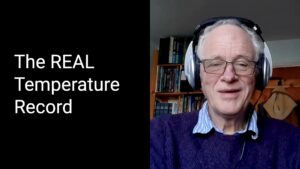The REAL Temperature Record: A Conversation with Professor Phil Jones
In this milestone episode of Let’s Climunicate, host Dr. Alberto Troccoli welcomes Professor Phil Jones, a globally respected climate scientist known for his foundational work on global temperature records. The conversation offers not only scientific clarity but a deeply personal look at the journey of a scientist navigating both data and public discourse.
From Hydrology to Global Climate Pioneer
Professor Jones didn’t set out to study climate. Initially trained in hydrology, he found himself drawn into climate science during a short-term contract at the University of East Anglia’s Climatic Research Unit in 1976. That “temporary” job turned into a four-decade career, during which he helped develop one of the most cited global temperature datasets in the world.
Building the Temperature Record
How do scientists determine that the world has warmed by ~1.5°C since pre-industrial times? Jones explains that the answer lies in the careful integration of temperature records from land and ocean, supported by proxy data such as ice cores and tree rings. Despite differences in method, multiple global datasets—including HadCRUT, NOAA, NASA, and Berkeley Earth—consistently show the same trend: a clear and accelerating warming.
One reason for this consistency, he notes, is the concept of “spatial degrees of freedom.” Surprisingly, just 100 well-distributed measurement points are enough to reconstruct a reliable global average—a finding that reinforces confidence in historical temperature trends.
Jones also challenges the popular narrative around the so-called “Medieval Warm Period” pointing out that the warming was not global, but rather regionally limited—a distinction often lost in public discourse. As he notes, referring to it as a single, well-defined global period is a misnomer that oversimplifies complex climate variability.
Correcting for Change: Instruments, Oceans, and History
Phil walks us through the evolution of measurement techniques—from unshielded thermometers to standardised Stevenson screens, from wooden buckets hauled from the sea to automated buoys. These changes introduce complexities, but also demonstrate the scientific community’s diligence in correcting biases and improving data quality.
He also highlights the marine temperature record, including adjustments for evaporative cooling in early sea surface measurements. These careful corrections are why we can trust the long-term trends, even across different regions and instrument generations.
Climategate, Controversy, and Confirmation
Jones openly addresses the 2009 Climategate scandal, a period of intense media scrutiny. Despite criticism, subsequent investigations and independent efforts—like the Berkeley Earth project funded by alternative climate scientists —ultimately confirmed the validity of the existing global temperature record. Jones emphasises that while such controversies are challenging, they also underscore the importance of transparency, scientific rigour, and open communication.
Looking Ahead: What the Data Tell Us
From his perspective, the global temperature is likely to rise by another 1.5°C by the end of the century, potentially surpassing key climate tipping points. Yet, he cautions against over-simplifying the story. Climate variability exists, but today’s warming is distinct in speed and scale. Jones underscores the need for robust, continuous data and communication to guide both policy and public understanding.
This episode offers a rare glimpse into the detailed work behind global climate trends—and the resilience of the people who dedicate their lives to understanding them.




